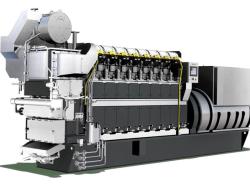
OR WAIT null SECS
© 2024 MJH Life Sciences™ and Turbomachinery Magazine. All rights reserved.
Renewables provide new life for 100-year old technology for grid
This year, GE is celebrating its 100-year anniversary of supplying synchronous condenser solutions to utility customers and transmission system operators. As many transmission networks around the world are struggling with weak grid conditions as a result of retiring legacy thermal generation units and the intermittency of wind and solar power, this technology—once considered nearly obsolete—has reinvented itself and now provides critical support to a transforming grid.
Installed at strategic intervals along a transmission system, synchronous condensers are electrical rotating equipment that produce or absorb reactive power to keep the current flowing consistently to the grid – helping to ensure reliable power is available for those who need it, when they need it. The company’s latest synchronous condenser offerings have undergone many developments since 1919, when GE shipped the world’s first high voltage synchronous condenser to Ontario Hydro in Canada.
The original 10 Mvar model has evolved over the past century to meet evolving grid demands. GE now offers the broadest synchronous condenser portfolio in the industry, with units ranging from 20 Mvar all the way up to more than 300 Mvar in a single piece of equipment. As a utility industry leader, GE has supplied more than 200 synchronous condensers to utilities around the globe. Significant technology milestones include:
Synchronous condenser technology has been around almost as long as the electric grid itself to support transmission system reliability. As the grid became more mature and reliable over the decades, synchronous condenser eventually became regarded as obsolete, with many utilities discontinuing use of the technology. Today, however, as the grid has experienced increasing instability, the technology is undergoing a major comeback with all major synchronous condenser manufacturers reporting higher sales.
“The biggest factor in this renaissance is the changing generation mix of less traditional thermal energy and more wind and solar energy,” said Fabrice Jullien, Global Flexible Alternating Current Transmission Systems (FACTS) business leader for Grid Integration Solutions, GE Renewable Energy’s Grid Solutions business. “Because the best sites for renewable power generation often are not adjacent to where the power is needed, an effective and affordable transmission infrastructure is paramount.”
FACTS devices such as SVCs and STATCOMs are good at supplying reactive power quickly. They are less helpful at handling low system inertia, a measure of the stored energy within the mechanical rotating machine as well as low short-circuit strength in the power grid. Synchronous condensers can help meet these reactive power needs and boost system inertia and short-circuit strength.
Advanced technological improvements are also driving the acceptance of synchronous condensers. While older analog control systems and rheostats were unable to provide adequate response to dynamic events, the latest machines come with digital field exciter control systems and protective relays. The speed and precision of modern exciters allow the performance of new synchronous condensers to rival their SVC counterparts. Moreover, machine manufacturing and construction have advanced over the years. Slow speed 10- or 12-pole condensers are a thing of the past, and today’s better-insulated, brushless machines offer significantly higher reliability and availability with reduced maintenance costs.
“As the demands of the grid have changed over the past 100 years, GE’s synchronous condenser technology has changed with it. Today our synchronous condensers are enabling a clean energy future by supporting the integration of more renewable energy into the mix in a reliable way,” said Kevin Cogo, Rotating Equipment leader for GE Steam Power. “Our 100 years of experience, and the learnings that have been developed over that time, have GE well positioned to support our utility customers and transmission system operators as they navigate a dynamic energy landscape.”


